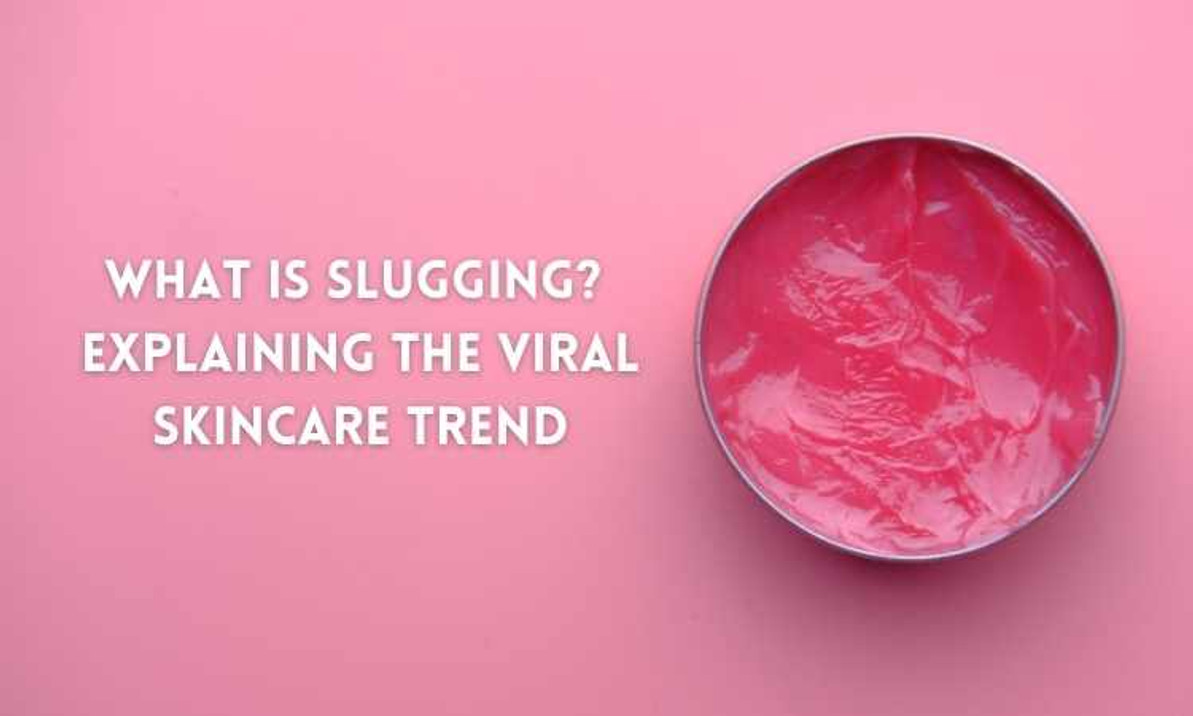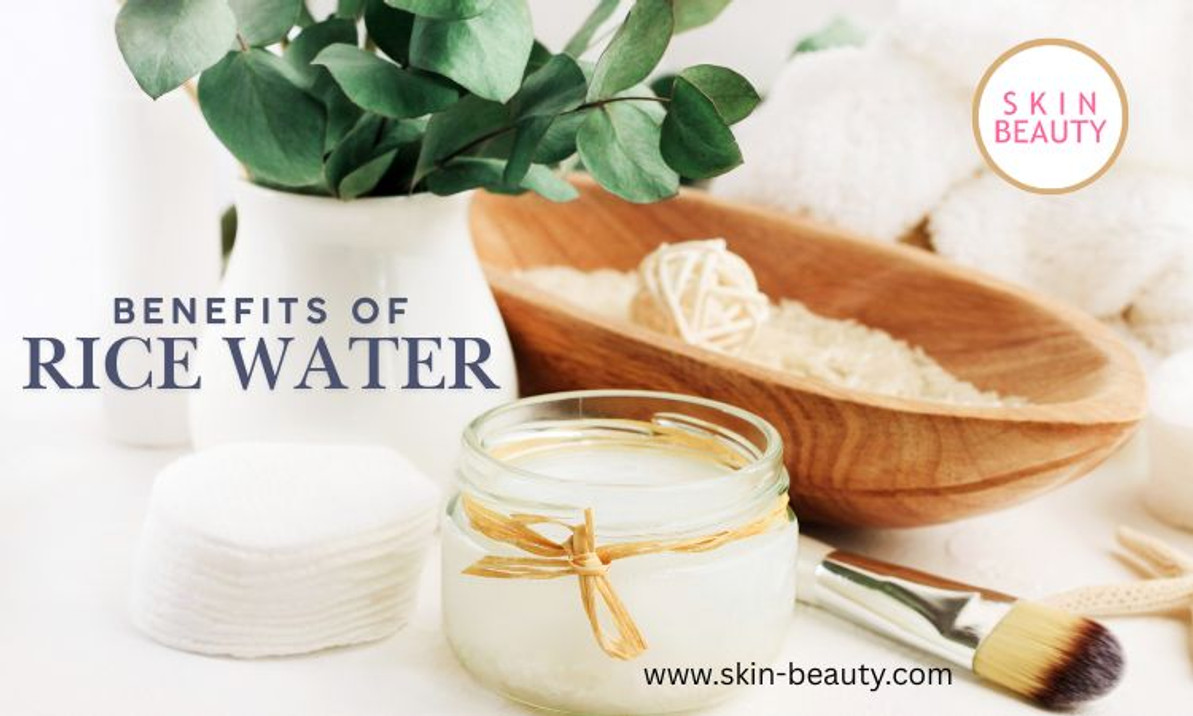Slugging Benefits: Explaining the Viral Skincare Technique
It seems like there is a new viral skincare trend and technique every week! And the recent trend of slugging is no exception.
A technique used by dermatologists and women of color for decades, it's recently become popularized as part of K-beauty due to its success in making skin smooth and even more hydrated than before!
The slugging technique has gained newfound popularity after skincare enthusiasts shared their love for it on the popular Skincareaddiction subreddit and the slugging hashtag amassed over 1.5 million views on TikTok.
What is slugging in skincare?
Slugging has recently been popularized by K-beauty. It involves applying an overnight ointment to your face, preventing transepidermal water loss, and keeping moisture inside skin cells - it's like a moisturizer but more intense!
The standout product in this routine is the use of occlusives. They can be anything from oils or waxes that make up a protection layer, think Vaseline (petroleum jelly); they help heal wounds by preventing them from drying out further and providing soothing relief. This occlusive product is the key to sealing the ingredients and trapping moisture overnight.
What are the slugging benefits for your skin?
The main benefit of slugging is to prevent transepidermal water loss, lock moisture, and improve skin barrier function, leaving hydrated and plump skin. It can also help with the absorption of other skin care products (serums, ampoules, creams) as they would be applied under the occlusive layer, theoretically allowing them to penetrate the skin on a deeper level because they cannot evaporate. Your occlusive product (Cerave, Aquaphor, Vaseline, AnteAge) is the final layer in the slugging process, trapping moisture.
Many people who swear by the slugging technique say they can notice differences in their skin in as little as 8 hours! Their skin looks more plump and hydrated and, at times, can look less flaky. Those with dry skin typically notice the biggest difference. But, of course, all skin types are different, and this technique may not work for everyone.
Is slugging suitable for sensitive skin?
The benefits of slugging are appealing. I mean, dry skin gone overnight? Sign me up! And with its widespread use and tutorials on social media, it can be very tempting to try this at home. But, as with many things we see on the internet, take it with a grain of salt and do your research, as slugging may not be suitable for all skin types.
Due to the slugging process's hydrating purpose, it is a skincare technique recommended for those with drier and more sensitive skin types. In addition, those with skin irritation or eczema can also benefit from slugging as this technique can help restore barrier function leaving hydrated and healthy skin.
This also means that if your skin barrier needs restoring or has been obliterated by over-exfoliating, slugging may help speed up the restoration process. Ideally, using other serums (hyaluronic acid) can help boost hydration but be aware that using potentially irritating actives can burn or irritate sensitive skin.
There is also the option of spot slugging, which means you only apply the slugging steps to very dry skin areas of your face. This technique also works well if you have a combination skin type. Speak with your board certified dermatologist before trying a new skin care trend.
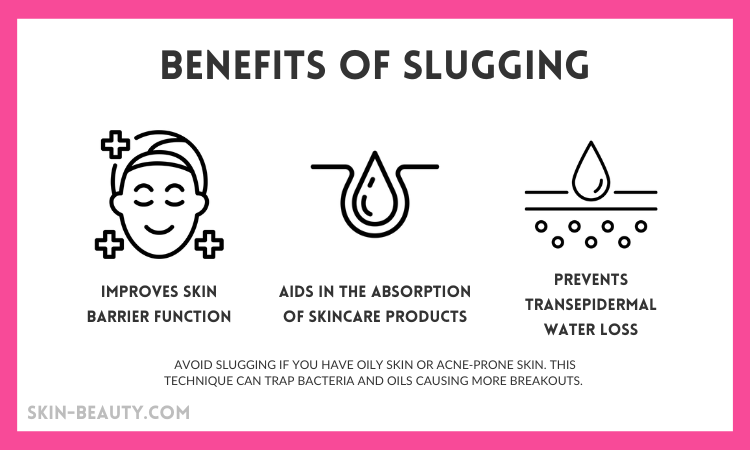
Is slugging good for oily skin?
Slugging is generally not recommended for oily skin types. Sure, oily skin may mean that your skin needs some hydration, and what better technique to help with that than slugging? Well, as with all things you see on the internet, what works for one may not work for all.
Slugging on oily skin may cause clogged pores which can lead to breakouts. Many who have tried slugging on their oily skin say that you may get results initially, and your skin will look great. But as time passes, they experience more and more breakouts due to using so many hydrating products.
Conduct a patch test first, or speak with your board certified dermatologist or licensed esthetician to see if slugging is something that can benefit you or if there are other ways to achieve glowing and dewy skin.
Slugging for acne-prone skin
If your skin is acne-prone, you may want to skip slugging. Because slugging traps any ingredients to retain moisture, it could also trap more acne-causing bacteria leading to more breakouts. Unfortunately, this also means that the richness of ingredients and moisturizing products can lead to clogged pores, causing more breakouts. This is why acne-prone skin types are generally recommended to avoid slugging.
Although various users on the subreddit Skincareaddiction swear by this technique in combination with the acne medication, tretinoin. According to them, slugging works better than most moisturizers to keep the skin hydrated once your skin has reached a certain level of dryness.
Of course, it is always recommended that you consult with your skin professional or dermatologist before adding a new technique to your routine.
Why is slugging in my skin care routine breaking me out?
So, you don't have acne-prone skin, and slugging is still breaking you out. Why is that? Well, there could be a couple of reasons, like:
1. Slugging may not be for your skin type.
Slugging may be too rich for you, which is why it is generally recommended for dry skin types or for certain skin types during the winter months. Even though slugging may recommend for your skin type, everyone is different, and not all treatments will work for you.
This is why dermatologists recommend conducting a patch test before trying out a new product or treatment, to see if your skin reacts.
2. You are not using the right products.
Sometimes it takes a little bit of experimenting to find the products that will work best for your skin and your routine. Vaseline (petroleum jelly), Aquaphor, and Cerave Healing Ointment are the most recommended products for slugging, but those don't always yield the best results for everyone.
Some petrolatum based ointments may not be ideal for certain skin types, so other occlusives may help in preventing water loss and creating a protective barrier for your skin. Nevertheless, using the best products can help minimize the chance of breakouts.
Another thing to consider is the skin care products you are using in your prep. Using various hydrating ingredients may be too much for your skin and cause breakouts.
3. You are using too much of each product.
The biggest question with slugging is, "how do I keep my pillowcase clean?" The answer is that you shouldn't use enough product to leave it on your pillowcase. When using your occlusive or petrolatum based ointment a thin layer or dime size amount should be enough for your entire face.
It's also important to not over-tone or uses too much serum on the skin, always apply the recommended amounts and let each layer fully sink into the skin before moving on.
4. You are not properly cleansing and toning the skin.
Properly cleansing and toning the skin is crucial in slugging and reducing the chance of breakouts. Always apply all products to clean skin. After cleansing, apply a toner (preferably alcohol-free, witch hazel is ok) to reset your skin's pH levels and clear out any remaining sebum or gunk that can cause breakouts.
This is important because the point of slugging is to trap in the products you have applied, and without proper cleansing and toning, you may be trapping acne-causing bacteria.
What products protect my skin barrier when Slugging?
Now that you know how slugging helps certain skin types improve, you have to ask yourself what to use for skincare slugging for that glowing skin.
You can use many products marketed for slugging, but you can also use products that contain jojoba oil, sunflower seed oil, or shea butter. Although we recommend using an occlusive or a product that contains petrolatum or shea butter as sometimes oils (although effective) can cause irritated skin.
An occlusive product can be things like Vaseline or Aquaphor. Looking for a product with petroleum jelly is ideal because that is what creates a barrier and traps moisture in your skin. Balms designed for post-peel care or other facial treatments are a great option to use in place of your regular occlusive, like Vaseline (petroleum jelly).
Although Vaseline (petroleum jelly) and Aquaphor may be more accessible, occlusives created to protect the skin barrier will be more effective. These products have shea butter, petroleum jelly, and other ceramides that can help soothe and hydrate the skin while minimizing the potential for breakouts and protecting the skin barrier.
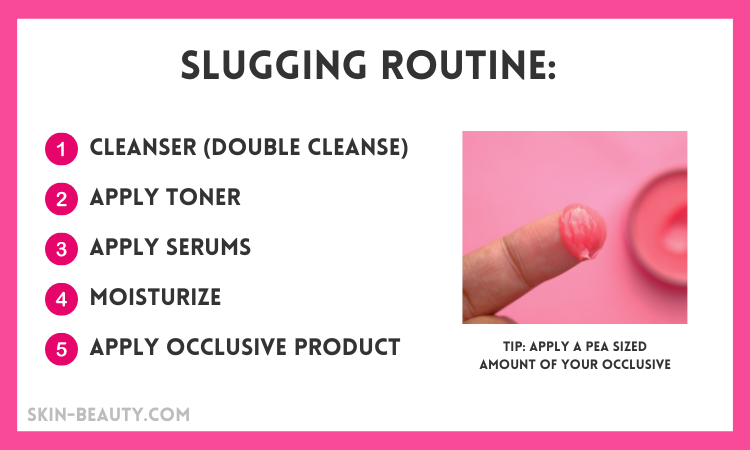
The slugging process
So now you've decided you want to give this slugging technique a try. Here are the slugging skincare steps:
- Cleanse
- Toner
- Serum
- Moisturize
- Occlusive product
After removing your makeup, cleanse and pat your skin dry with a soft cloth. Use a gentle cleanser or face wash that won't further dry out the skin and avoid using cleansers and toners with alcohol to avoid skin dryness.
Cleanser Recommendations:
This step is important to remove extra congestion in the pores. Congestion may lead to acne and negative results. Apply your toner to damp skin for best results.
Recommended Toners:
This step is optional, but to maximize the skin's hydration a serum will help. Hyaluronic acid is ideal for this technique, but most serums that are humectants should work well with occlusives. But if there is a serum (those with beta hydroxy acids and alpha hydroxy acids) that works for your skin, don't stress about replacing it.
Recommended Hyaluronic Acid Serums:
A moisturizer will help with hydration. A ceramide cream or cream with hyaluronic acid is ideal.
Recommended Moisturizers:
The final step in your skin care routine should be to apply a thin layer of your slugging product. This traps in the previous skincare products you used so they can set into the skin overnight. Do not apply any other products afterward; your occlusive should be the final product and last step in your skincare routine.
Occlusive Recommendations
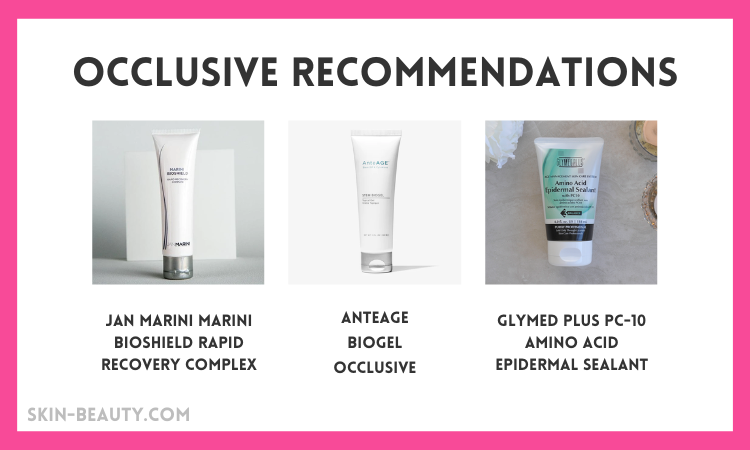
The main goal of slugging is preventing trans epidermal water loss in the skin by using an occlusive ointment to create a protective layer on the skin. Slugging is a process that many people are unfamiliar with, but it can have many benefits for your skin depending on your skin type and condition.
We've outlined the basics of slugging and which products you can use to get started. Will you try slugging? Let us know how it goes!
Recent Posts
-
Best Face Wash for Sensitive Skin
My Journey to Finding the Best Face Wash for Sensitive Skin If you’re reading this, you probab …Apr 22nd 2025 -
Best Under-Eye Bags Cream and Treatment
Best Under-Eye Bags Cream and Treatment Do you have the dreaded under-eye bags that make you look l …Apr 14th 2025 -
Rice Water for Skin Benefits
Rice Water for Skin Benefits Rice water for skin has become a viral beauty trend that is supposed t …Apr 4th 2025

